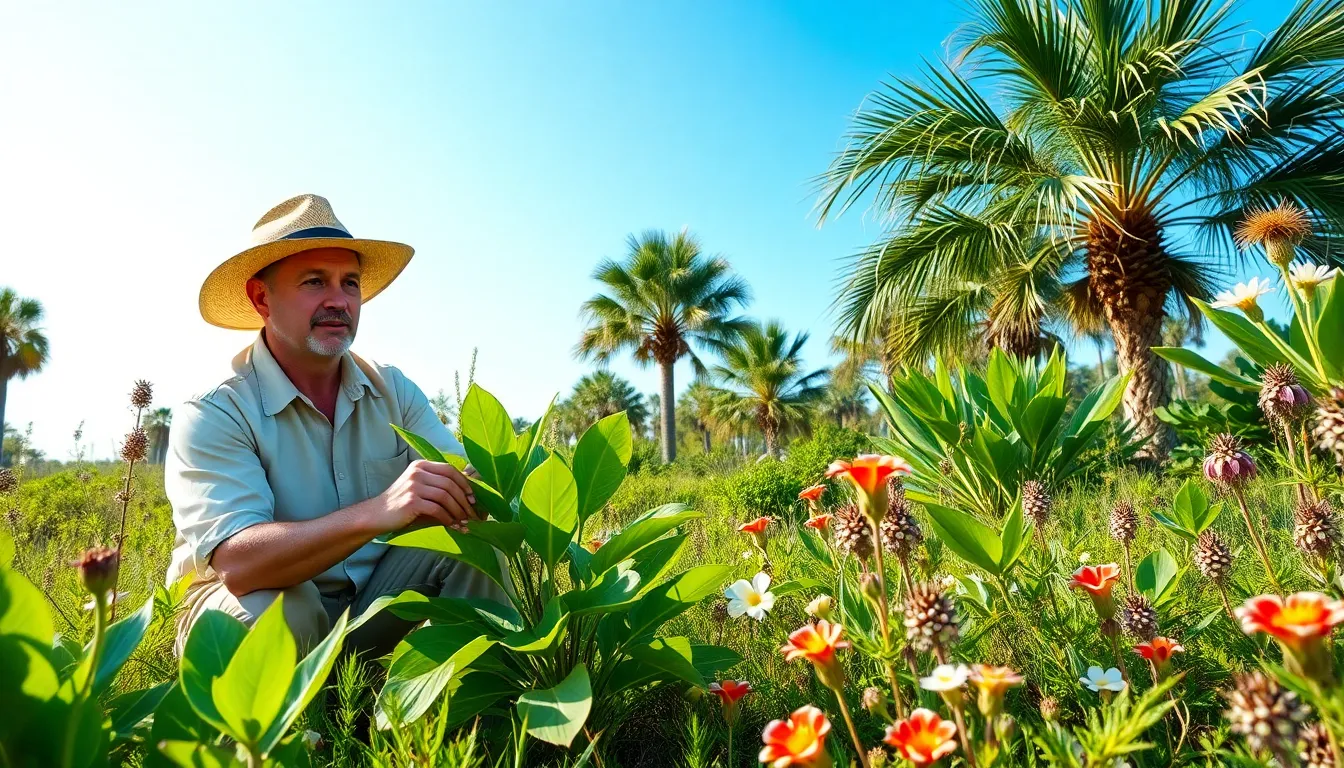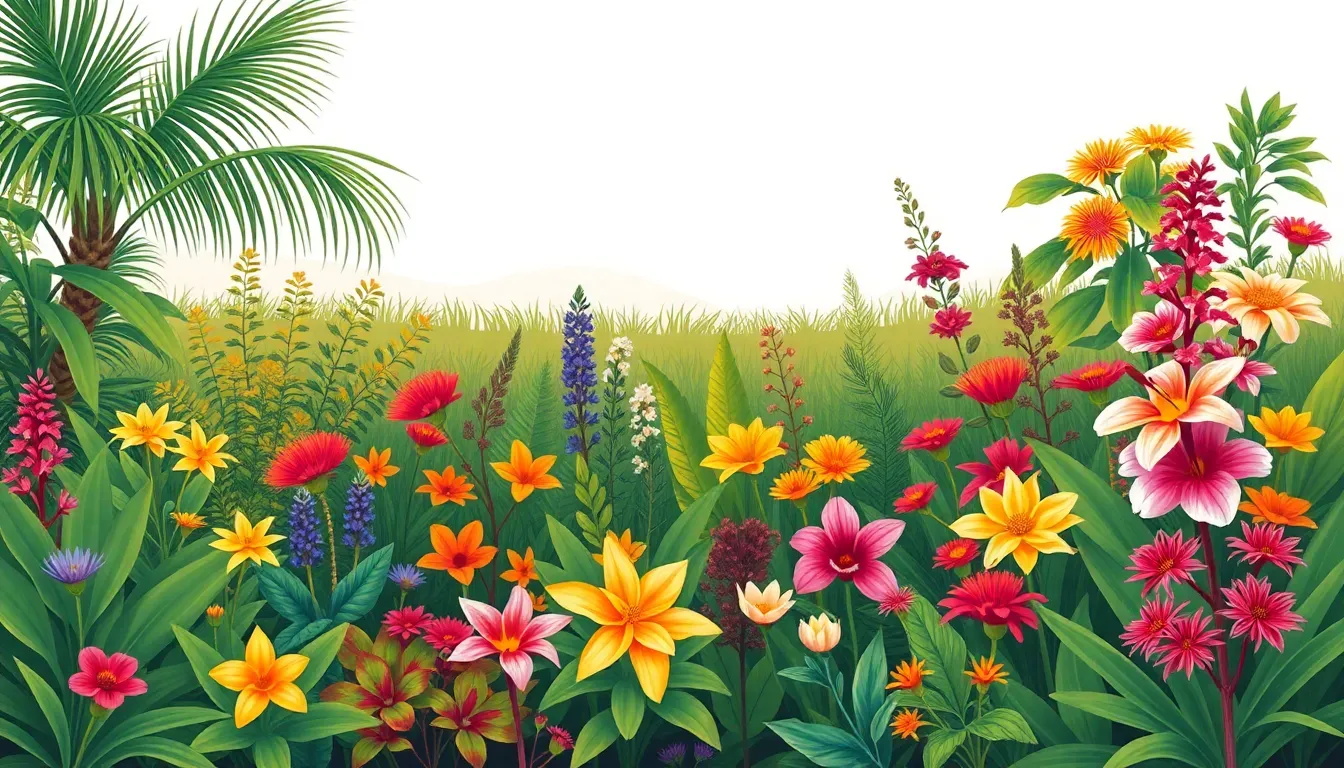Phone:
(701)814-6992
Physical address:
6296 Donnelly Plaza
Ratkeville, Bahamas.

Florida’s lush landscapes are a botanical wonderland, brimming with vibrant plants that can easily confuse even the most seasoned nature lover. From the towering palm trees to the colorful hibiscus, identifying these flora isn’t just a fun pastime—it’s essential for gardeners, hikers, and anyone who wants to avoid an awkward encounter with poison ivy.
Florida hosts a rich variety of plant species, showcasing unique ecosystems ranging from wetlands to hardwood forests. Given the state’s climate, numerous native and non-native plants thrive in diverse environments. Recognizing these plants proves essential for outdoor enthusiasts. Gardeners benefit from familiarity with local flora, while hikers should note the presence of species such as poison ivy.
Identification varies by region, emphasizing the need to understand distinct characteristics of plants. Leaf shape, flower color, and growth habits aid in distinguishing species. For example, saw palmetto appears as a low-growing shrub with fan-shaped leaves, primarily found in coastal areas. Contrarily, mangroves thrive in brackish waters and possess thick, tangled roots.
Guides and apps facilitate the identification process. Resources like the “Florida Landscape Plant Handbook” support both beginners and experienced botanists. Observers should consider local conservation efforts, as identifying endangered or invasive species aids environmental initiatives.
In addition to visual characteristics, understanding habitat plays a crucial role. Wetlands host different plants compared to upland areas. Familiarity with specific habitats enhances one’s ability to engage with the state’s diverse plant life.
Engaging with Florida’s flora encourages deeper appreciation for biodiversity. Enthusiasts can participate in local workshops or join plant identification groups to expand knowledge. With careful observation, anyone can become adept at recognizing Florida’s unique plant species.

Understanding plant identification enhances experiences in Florida’s lush landscapes. Recognizing various species promotes safety, enjoyment, and ecological awareness.
Effective plant identification informs successful landscape design. Knowledge of native species aids in creating sustainable and resilient gardens. Choosing the right plants contributes to aesthetic appeal while supporting local wildlife. Homeowners can select species that thrive in specific conditions, reducing maintenance efforts. Proper identification prevents the introduction of invasive plants that disrupt ecosystems. Overall, landscape designs integrating well-identified plants lead to healthier environments and beautiful outdoor spaces.
Plant identification plays a crucial role in maintaining Florida’s ecosystems. Each species contributes to the ecological balance, providing habitats and food sources for wildlife. Understanding local flora enhances awareness of biodiversity and conservation efforts. Recognizing endangered species promotes protection and preservation initiatives. Environmental health benefits from identifying invasive species and mitigating their impact. Communities invested in ecological education foster a sustainable relationship with their surroundings. By focusing on plant identification, individuals contribute to the preservation of Florida’s unique ecosystems.
Florida showcases an impressive array of plant life, with unique trees, shrubs, wildflowers, and grasses thriving in its varied climates.
The state hosts iconic species like the Sabal palm and Southern live oak. Sabal palms, known for their fan-shaped leaves, often populate coastal areas, while Southern live oaks provide significant shade in hardwood forests. Additionally, the Red maple, recognizable by its vibrant fall foliage, graces wetlands and floodplains. Bluejack oak serves a dual purpose, offering habitat for wildlife and a stunning display of greenery in upland areas. Understanding these species aids outdoor enthusiasts in effectively recognizing native flora.
Wildflowers illuminate Florida’s landscapes with color. The Coreopsis, named the state flower, boasts bright yellow blooms from spring to summer, attracting pollinators. Salvia and Blanket flower contribute vibrant hues to gardens and natural areas. Among grasses, Florida’s native species, such as Bahiagrass and Wiregrass, prevail in grasslands and coastal regions. These grasses support wildlife, stabilize soil, and prevent erosion. Identifying these wildflowers and grasses enriches experiences in Florida’s natural settings.
Various resources exist for identifying plants in Florida, assisting enthusiasts and professionals alike in their endeavors. Utilizing these tools enhances the outdoor experience and fosters a greater appreciation of the state’s unique flora.
Field guides such as the “Florida Landscape Plant Handbook” provide detailed descriptions and images of native species. Apps like “PlantNet” and “iNaturalist” allow users to identify plants through photos and community engagement. Both formats feature essential information on growth habits and habitats. Resources like these enable quick access to critical data, fostering accurate identification during hikes or landscaping projects.
Online databases such as the “USDA PLANTS Database” and “Wild Florida” host extensive information about Florida’s flora. These platforms offer species descriptions, distribution maps, and images. Community forums on sites like “GardenWeb” serve as platforms where enthusiasts exchange tips and experiences. Such interactions build networks of knowledge for plant identification, promoting collaboration and learning among users.
Identification techniques play a crucial role in recognizing Florida’s plant life. Utilizing effective methods can enhance one’s experience in the state’s diverse ecosystems.
Observational skills are fundamental for successful plant identification. Focusing on details helps differentiate species. Noticing color variations in leaves and flowers can reveal necessary information. Maintaining attention to the surrounding habitat offers context for plant characteristics. Observers should familiarize themselves with seasonal changes, as many plants exhibit different features throughout the year. Engaging in active observation promotes a deeper understanding of local flora.
Identifying key characteristics supports accurate plant recognition. Leaf shape stands out as a primary attribute, with variations among species such as broad, needle-like, or lobed forms. Flower color and arrangement provide additional clues, indicating specific plant groups. Bark texture and color vary greatly; examining these traits aids in narrowing down possibilities. Growth habits, such as size and whether plants are herbaceous or woody, also contribute to identification. Collectively, these characteristics enable enthusiasts to classify plants effectively in Florida’s ecosystems.
Understanding Florida’s plant life is essential for anyone who spends time in its diverse landscapes. The ability to identify local flora not only enhances outdoor experiences but also supports conservation efforts and sustainable gardening practices. By utilizing available resources and honing observational skills, individuals can navigate the rich ecosystems of Florida with confidence.
This knowledge fosters a deeper appreciation for the state’s natural beauty while promoting the protection of its unique biodiversity. Engaging with Florida’s plant life ultimately contributes to a healthier environment and a more enjoyable outdoor lifestyle.